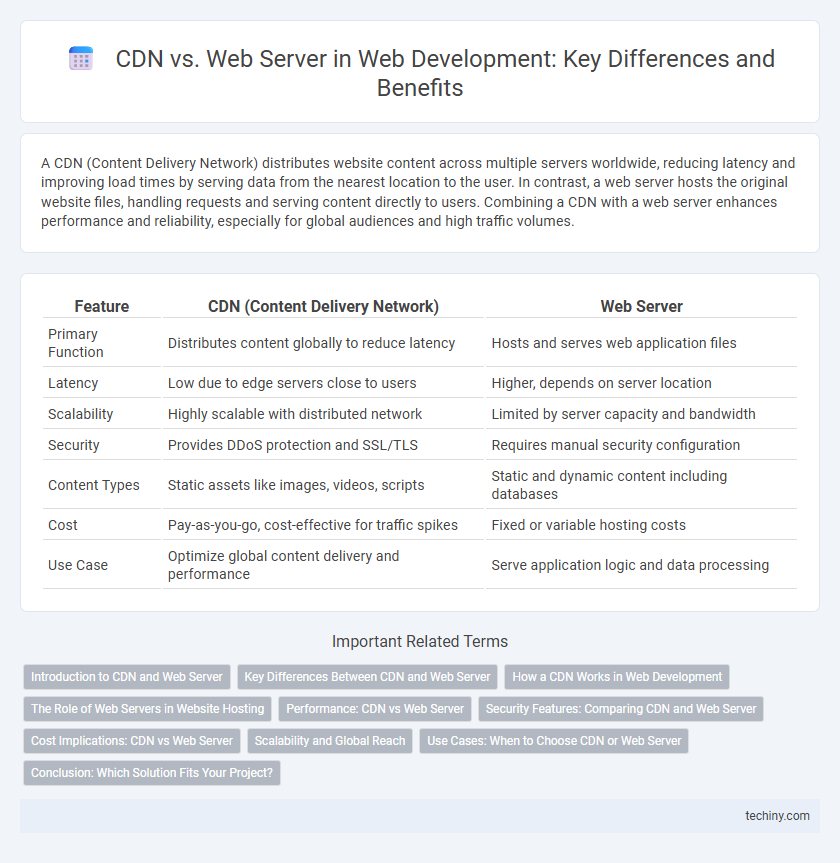A CDN (Content Delivery Network) distributes website content across multiple servers worldwide, reducing latency and improving load times by serving data from the nearest location to the user. In contrast, a web server hosts the original website files, handling requests and serving content directly to users. Combining a CDN with a web server enhances performance and reliability, especially for global audiences and high traffic volumes.
Table of Comparison
| Feature | CDN (Content Delivery Network) | Web Server |
|---|---|---|
| Primary Function | Distributes content globally to reduce latency | Hosts and serves web application files |
| Latency | Low due to edge servers close to users | Higher, depends on server location |
| Scalability | Highly scalable with distributed network | Limited by server capacity and bandwidth |
| Security | Provides DDoS protection and SSL/TLS | Requires manual security configuration |
| Content Types | Static assets like images, videos, scripts | Static and dynamic content including databases |
| Cost | Pay-as-you-go, cost-effective for traffic spikes | Fixed or variable hosting costs |
| Use Case | Optimize global content delivery and performance | Serve application logic and data processing |
Introduction to CDN and Web Server
A Content Delivery Network (CDN) is a distributed network of servers designed to deliver web content efficiently by caching static assets closer to users worldwide. A web server is a hardware or software system that stores, processes, and delivers web pages to clients via HTTP or HTTPS protocols. CDNs reduce latency and improve load times by offloading traffic from origin web servers, enhancing overall website performance and reliability.
Key Differences Between CDN and Web Server
CDNs (Content Delivery Networks) distribute website content across multiple global servers to reduce latency and improve load times, while web servers host the original content and process requests locally. CDNs cache static assets like images, videos, and scripts closer to end-users, optimizing delivery efficiency, whereas web servers handle dynamic content generation and application logic. The primary distinction lies in CDNs enhancing speed and scalability through geographically dispersed nodes, whereas web servers provide the core infrastructure for hosting and serving web applications.
How a CDN Works in Web Development
A Content Delivery Network (CDN) works in web development by distributing website content across multiple geographically dispersed servers, ensuring faster load times by serving data from the closest server to the user. CDNs cache static assets like images, CSS, and JavaScript files, reducing the load on the origin web server and improving overall website performance and scalability. This decentralized approach enhances security against DDoS attacks while maintaining high availability and reliability for global users.
The Role of Web Servers in Website Hosting
Web servers are critical in website hosting by storing, processing, and delivering web pages to users through HTTP requests. Unlike CDNs that distribute content globally to reduce latency, web servers manage the core application logic, database interactions, and dynamic content generation. Efficient web server configuration directly impacts website performance, uptime, and user experience in web development.
Performance: CDN vs Web Server
Content Delivery Networks (CDNs) significantly enhance web performance by distributing cached content across multiple geographically dispersed servers, reducing latency and load times compared to a single centralized web server. CDNs optimize bandwidth usage and improve scalability by offloading traffic from the origin web server, ensuring faster content delivery during traffic spikes. Web servers, while essential for dynamic content generation, can experience bottlenecks and slower response times under heavy load without CDN support.
Security Features: Comparing CDN and Web Server
Content Delivery Networks (CDNs) enhance security by providing Distributed Denial of Service (DDoS) protection, Web Application Firewall (WAF) integration, and SSL/TLS encryption at edge locations, reducing the attack surface on origin servers. In contrast, traditional web servers rely heavily on server-side security configurations and perimeter defenses, often lacking the global resilience and real-time threat mitigation offered by CDNs. Implementing a CDN significantly reduces latency while offloading security responsibilities from the web server, creating a robust defense against cyber threats and improving overall site availability.
Cost Implications: CDN vs Web Server
CDNs reduce bandwidth costs by caching content closer to users, lowering server load and minimizing data transfer expenses for web servers. Web servers incur higher costs due to direct handling of all requests, requiring more robust infrastructure and increased bandwidth. Choosing a CDN often leads to significant savings in operational expenses and improves site performance for distributed traffic.
Scalability and Global Reach
Content Delivery Networks (CDNs) enhance scalability by distributing web content across multiple geographically dispersed servers, reducing latency and managing traffic spikes efficiently. Traditional web servers often face limitations in handling global traffic due to centralized resources, leading to slower load times and potential bottlenecks. Leveraging a CDN ensures high availability and optimal performance worldwide, making it essential for scalable web development.
Use Cases: When to Choose CDN or Web Server
CDNs excel at delivering static content such as images, videos, and stylesheets quickly by caching files across multiple geographic locations, reducing latency and improving load times for global users. Web servers are ideal for serving dynamic content and handling backend processes, including database interactions and user authentication, where real-time data processing is required. Choosing a CDN is best for scalability and minimizing server load during traffic spikes, while web servers are preferred for personalized content delivery and server-side application logic.
Conclusion: Which Solution Fits Your Project?
Choosing between a CDN and a web server depends on your project's scale, performance requirements, and geographic audience distribution. CDNs enhance load speeds and reliability by caching content across multiple global nodes, ideal for high-traffic, international sites, whereas web servers offer more control and customization suitable for localized or dynamic content needs. Evaluating factors like latency sensitivity, traffic volume, and content type ensures optimal infrastructure alignment for your web development project.
CDN vs Web Server Infographic

 techiny.com
techiny.com